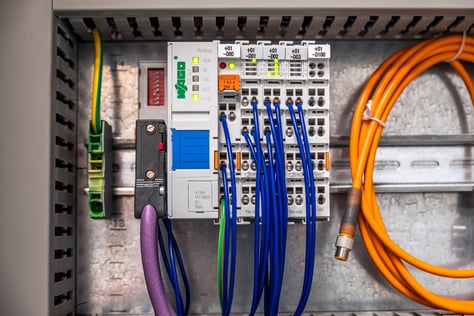 Edge controllers can provide advantages in many applications where traditional industrial controllers have been used. For commercial and industrial computing products, software and hardware development progress proceeds in tandem, with the lead alternating. Sometimes the software complexity and features increase in a way that bumps into processing limitations; then there are times when hardware advances unleash newfound capacity for more sophisticated software.
Edge controllers can provide advantages in many applications where traditional industrial controllers have been used. For commercial and industrial computing products, software and hardware development progress proceeds in tandem, with the lead alternating. Sometimes the software complexity and features increase in a way that bumps into processing limitations; then there are times when hardware advances unleash newfound capacity for more sophisticated software.
It is easy to look at today’s traditional operations technology (OT) industrial controller options, represented most often by traditional programmable logic controllers (PLCs) and process automation controllers (PACs), and see them as mature technologies with capable software and fast hardware. The challenge is identifying what comes next.
A few industry trends are pointing the way. Modern consumer and commercial computing experiences are ripe for merging into industrial products. Internet of Things (IoT) devices are becoming commonplace and many are looking at incorporating Industrial IoT (IIoT) devices into automation systems. Digital transformation requires connecting with many data sources, collecting and storing the data, visualizing and analyzing it, enabling optimized operations.
The journey to realize value in these trends calls for something new; an edge controller that is more than a PLC or a PAC. Edge controllers are making it possible for implementation of robust automation systems to continue as they always have and seamlessly add the latest communication and application development options.
Edge controllers can upgrade existing systems, create new designs, improve productivity, address skill gaps and enhance security.
Edge controller hardware and the software
Casual observers and implementers of industrial technology can be excused for believing the industrial controller world has plateaued in processing power and physical footprint, looking at simple processor clock speed.
Cutting-edge commercial and industrial processors, however, have realized substantial processing performance gains due to multi-core designs and increasing numbers of processor cores in a device. At the same time, hardware-level virtualization provides a convenient way to manage multiple cores and assign them to virtual machines (VMs).
PCs and servers used in conjunction with industrial controllers already benefit from this improved computing performance coming from the fast-paced commercial world.
Deterministic industrial control systems, on the other hand, require high speed, repeatable and time-based processor execution. Unlike many commercial applications, any industrial application of VMs and multi-core management must be free from jitter or any other deviations from reliable timely operation.
Realizing equivalent performance gains for industrial applications, therefore, requires a new class of controller, and the edge controller was born. (Figure 1). These controllers feature multiple cores managed through carefully crafted VMs. A real–time operating system (RTOS) supports reliable, deterministic runtime control, similar to a PLC or PAC. The real upgrade is the addition of a second on-board general-purpose operating system (OS) running a variant of Linux.
The two OSs are independent at the hardware level, but they are able to communicate with each other via OPC UA. The “open” general-purpose OS can even be rebooted independently without affecting the deterministic runtime.
Combining a deterministic runtime with a general-purpose OS is a true advancement that builds upon traditional control methods by enabling closely–integrated deterministic computing and secure real-time data access technologies.
What makes edge controllers different?
Conventional PLCs and PACs will continue to be available for many years, although today, many users find significant overlap in these product descriptions. The term PAC has been used to describe controllers with more advanced control strategies and communication capabilities than a PLC, but in fact, many PLCs have been creeping into PAC capability territory.
PLCs and PACs are good technologies developed during different eras. Edge controllers can update or replace PLCs and PACs to address current challenges. Edge controllers can offer advantages by implementing carefully–designed OSs for addressing OT and IT needs for control, communications, and application development.
As dedicated control devices with a specific functional scope, basic PLCs are often “bare metal” designs or use an extremely limited and proprietary OS. PACs gained more advanced communication and functional services, while preserving a deterministic runtime, through the use of an RTOS. For creating an edge controller, which adds at least one general-purpose OS in addition to the deterministic runtime, designers must address new considerations. Hosting all these functions in one OS puts deterministic performance at risk. Incorporating a bare-metal virtualization hypervisor, however, enables deploying a rock-solid deterministic runtime securely and independently in parallel with a general-purpose OS on the same platform (Figure 2). This foundation is crucial.
PLCs used to be isolated or they communicated with slow and cumbersome serial links. PACs included better industrial protocol implementation and Ethernet for improved connectivity and interoperability. Edge controllers deliver these advantages, but users must take things to a whole new level to perform in an increasingly IT-connected environment.
They should incorporate a management umbrella adding security and defenses suitable for prevalent IT-like issues like network storms and denial of service (DoS) attacks. In conjunction, IT-oriented protocols with built-in security such as OPC UA, MQTT and secure sockets (HTTPS, SSL, FTPS) can provide appropriately secure communications performance.
For application development, PLCs used mostly proprietary ladder logic and relatively rudimentary tools. Taking on some concepts from the greater software industry, PACs may offer a level of support for standard IEC–61131-3 programming languages, custom user code blocks, and some basic capabilities for code reuse and object-oriented design. A well–designed edge controller preserves the deterministic runtime, and adds a computing environment for performing analytics, data aggregation, and other advanced tasks.
The general-purpose OS allows application development in IT-oriented languages like C and C++, Python, and Java. The most flexible architectures can allow OT personnel to focus on the deterministic system, IT personnel can work on the general-purpose system, and the two groups can coordinate and crossover as needed or desired in a clearly defined manner.

How to move to edge control
When users only need a PLC/PAC feature set, they can still specify an edge controller to fill that role. Standard IEC-61131-compliant programming methods can be used, or even commercial languages like C. These users never need to access the general-purpose OS features if they choose not to.
Those interested and perhaps more tech-savvy, however, should look for edge controllers offering a native toolbox of IT-friendly features such as Linux OS, a Python interpreter, secure sockets, an embedded database and OPC Foundation OPC UA support. Part of the reason IT-friendliness is so important is because much today’s IIoT technology is built on Linux. Edge controllers provide an environment where users can safely and securely explore their while preserving deterministic operation.
With the deterministic and the general-purpose OS on one hardware platform, it is easier to securely coordinate the two, compared to deploying separated devices. The general-purpose OS has access to wider variety of information sources and high-fidelity data from the deterministic system and IIoT devices. It also can perform local analytics and advanced algorithm execution.
The results can be used to advise the deterministic system for optimal operation. In addition, the general-purpose OS is ideal for transforming raw data into pre-processed information for securely sharing with higher level systems.
Controller usability
Modern edge controller technology can benefit those specifying, programming, and maintaining automation systems. At design time, users can select from product families sized to meet the need from small to large based on a performance and price standpoint, all using the same deterministic runtime environments, the same toolchains and configured with the same integrated development environment. Users only need to learn one common environment and the code and configurations can be reused.
Another consideration is how end user demographics are changing. Experienced users already in the workforce are familiar with PLC and PACs. Their depth of experience affords them a more instinctive approach to programming, tuning, and troubleshooting based on the products which have used for years.
The newest software users entering the workforce, however, have grown up in the smartphone age. They are used to modern programming languages and working in a developer kit environment rather than developing everything from scratch. In fact, they are probably most comfortable assembling code elements from a library or repository to create a solution (Figure 3).
Controllers fill the skills gap
The latest edge control automation platforms address the skills gaps in two ways. The first is younger workers will be more comfortable and perform better in a development environment that uses tools and languages familiar from their schooling or training. The second is edge control capabilities are a good way to create advisory algorithms to assist newer teams with operating and maintaining systems. Companies can rely on a smaller set of experts and improve their productivity by leveraging the expertise in the form of analytics and advising algorithms to empower the rest of the team.

Edge controller cybersecurity
Edge controllers, with their inherent connectivity and analytic capabilities, may raise security concerns for traditional controls developers. Developers accustomed to air-gapped networks as a standard security strategy may not be comfortable dealing with more open networks. Many older automation platforms also were developed before cybersecurity was considered a priority, and when security was addressed, it was more of an add–on afterthought than a built-in feature.
For edge controllers and the most modern PACs, on the other hand, security-by-design is a fundamental requirement. Suppliers of edge controller and PAC hardware and software products should be able to:
-Validate the supply chain
-Build their devices using trusted components and suppliers
-Incorporate hardware-based security technologies, such as trusted platform module (TPM) technology
-Utilize digitally signed and encrypted product firmware to guarantee software integrity.
Some vendors already offer software suites to help users navigate and manage security certificates, enabling simple, secure and encrypted communications right down to the application control level.
Automation product portfolios should provide the right tools to make strong IT-type security easy for operation technology (OT) users to apply.
Edge controller performance criteria
For industrial automation end users, the technology discussion today is less about product acronyms like PLCs and PACs and more about delivering the right performance. Some key performance criteria are:
-Achieving improved design, operating and maintenance productivity
-Addressing human factors associated with new workers and skill gaps
-Applying the best security in an increasingly connected world.
Edge controllers can help end users win in each of these areas by delivering a combination of the latest technology coupled with ease of use.
To learn more about Radwell International
For a behind-the-scenes look at Radwell
Darrell Halterman, senior product manager, Emerson
View the original article and related content on Control Engineering
https://www.controleng.com/articles/should-i-use-an-edge-controller-plc-or-pac/


